Welcome to a new issue of the Journal of Runic Studies, the premier Malkioni publication for studies into the nature of Glorantha. If you haven’t subscribed yet, please consult with the spirit bound to the appropriate electronic page.
God Learner Sorcery
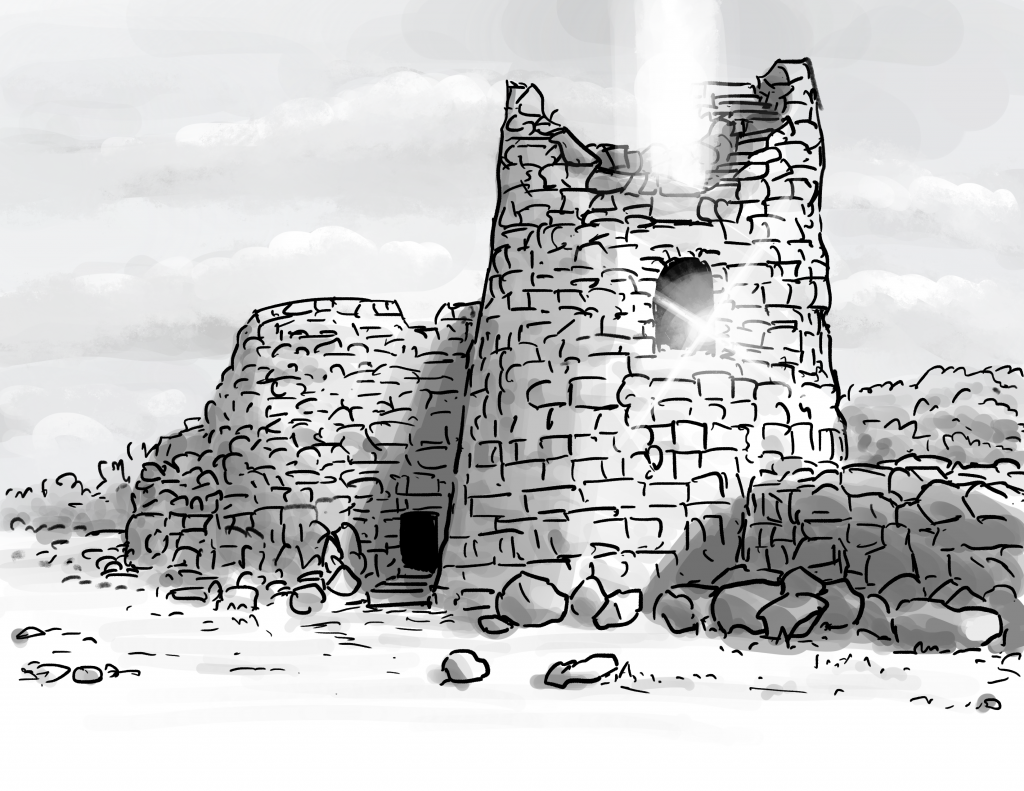
Here is what us God Learners were up to this week.
Initiation Series Episode 11: Juan, and the Most Unlikely Glorantha Book to Start With
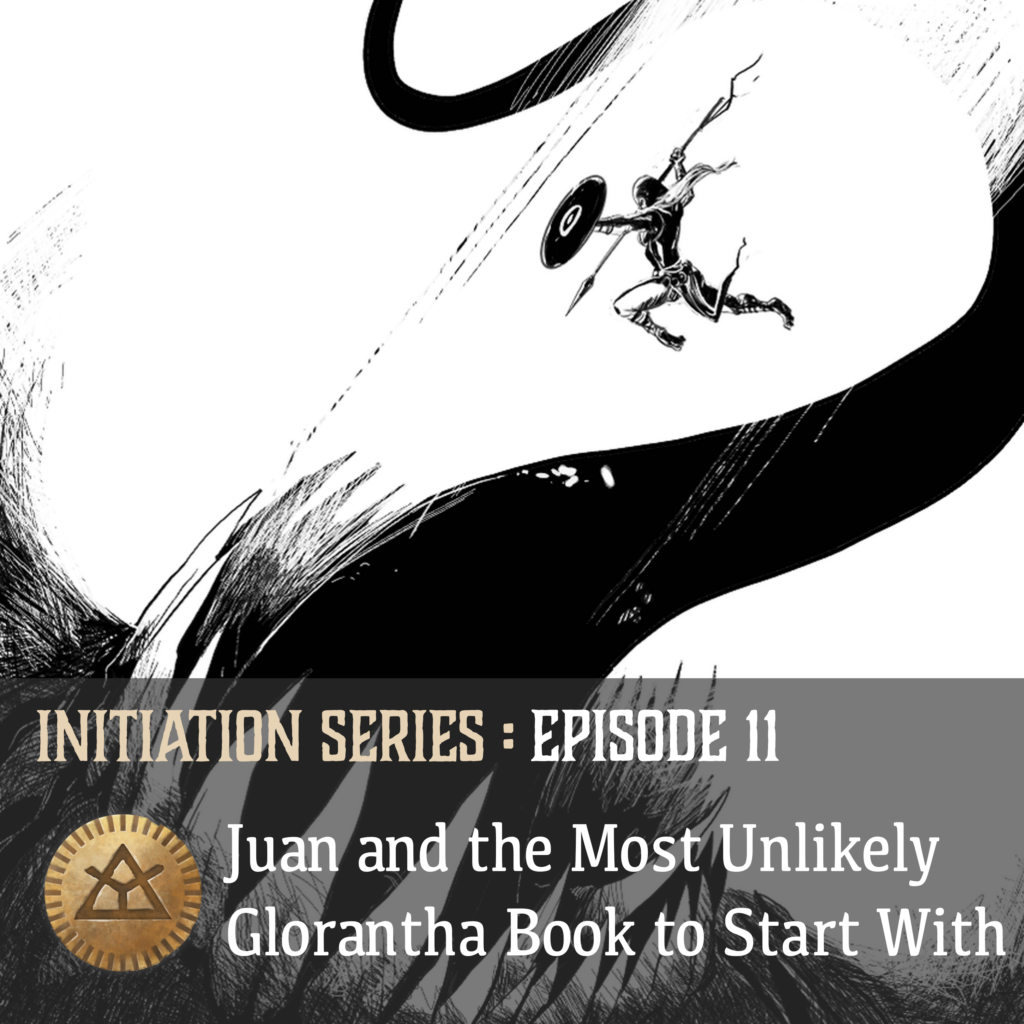
In episode 11 of our Initiation Series, we chat with Juan Ochoa, an illustrator that fell in love with Glorantha with the most unlikely book you could ever start with! We also talk about gaming shops in Columbia, alternative systems for Glorantha, avoiding the metaplot, linguisitcs, and more!
Chaosium News

Here are this week’s Chaosium news!
White Bull Campaign, A New Hero, and other RuneQuest Actual Plays
I just started catching up with the White Bull campaign after finishing the New Hero series which, by the way, James said would come back after GenCon but hasn’t yet… which makes me sad because it was quite good. They only ran two adventures but I found that they were both very Gloranthan and quite interesting.
As an aside, watching James, Bridgett, and David struggle at times with the rules lets me bang some more on that dead horse of mine that is the RuneQuest system. For instance, James mixes up the augment rules a few times, but that’s totally not his fault: it’s the system’s fault! It’s baffling to me that skill, Rune, and Passion augments don’t work the same, and that gamemasters and players need to memorize different modifier scales and mechanics for what should be, in my opinion, one simple unified mechanic. And then there are the success levels or the attack/parry results — I also don’t blame James here, because after running RuneQuest for a year and a half I still have to look them up on the gamemaster screen myself! But why? This could also be a much simpler unified mechanic…
Ultimately, I think this is why there’s virtually no RuneQuest actual plays out there apart from those that Chaosium directly sponsors. People who do actual plays want to provide compelling narrative entertainment, and that generally means using a system that “gets out of the way”. My theory is that the streamlining that went into Call of Cthulhu 7th edition played a big part in achieving that, which led to a lot of actual plays picking up the game, which in turn led to increased visibility and adoption. Crunchy systems don’t get a lot of air time, and RuneQuest is factually crunchy, I don’t care what the grognards say.
Miniatures VS Theatre of the Mind
Jeff’s latest interview on the Chaosium channel deals with “minitatures” vs “theatre of the mind”. Of the many discussion topics in TTRPG spaces, I think this is one where almost everybody agrees that “it depends” — it depends on the players and the group, it depends on the game, and so on. For instance, a game of Savage Worlds is more likely to have miniature combat compared to a game of Call of Cthulhu.
Personally, I find the dichotomy to be rather false. There are a few levels in between. For instance, I might most of the time start with theatre of the mind, but if players ask many questions about the environment, I might start to draw some crude map on a portable whiteboard or sheet of paper. These are (on purpose) too small to be used as any kind of battlemat so they are more akin to handouts. But then we might start drawing markers and arrows on there. And then sometimes we bust out the battlemat and use figurines.
Another thing that Jeff mentioned and that I’ve thought a lot about is how online play and VTTs are possibly skewing the new generation of gamers towards the “wargame end” of the spectrum. In my opinion, VTTs get RPGs wrong by reserving 90% of the screen to the map. When running online, I have the video feed of my players on my main screen. The VTT and everything else goes on the second screen. The people is the main thing.
TTRPG Writing Styles
Here is an interesting interview with Jason Durall (line editor for RuneQuest, but also a prolific author and editor with other publishers besides Chaosium). It deals with the various tones and writing styles found in RPGs, and how they fit different games. This is potentially insightful for Jonstown Compendium authors, for instance.
Jonstown Compendium

The Jonstown Compendium is Chaosium’s community content program for all Gloranthan games, hosted on DriveThruRPG. Disclaimer: all the relevant links are affiliate links that hopefully will let us cover some of the hosting and maintenance costs for the website and podcast! Thanks for using them!
Somewhere in Glorantha
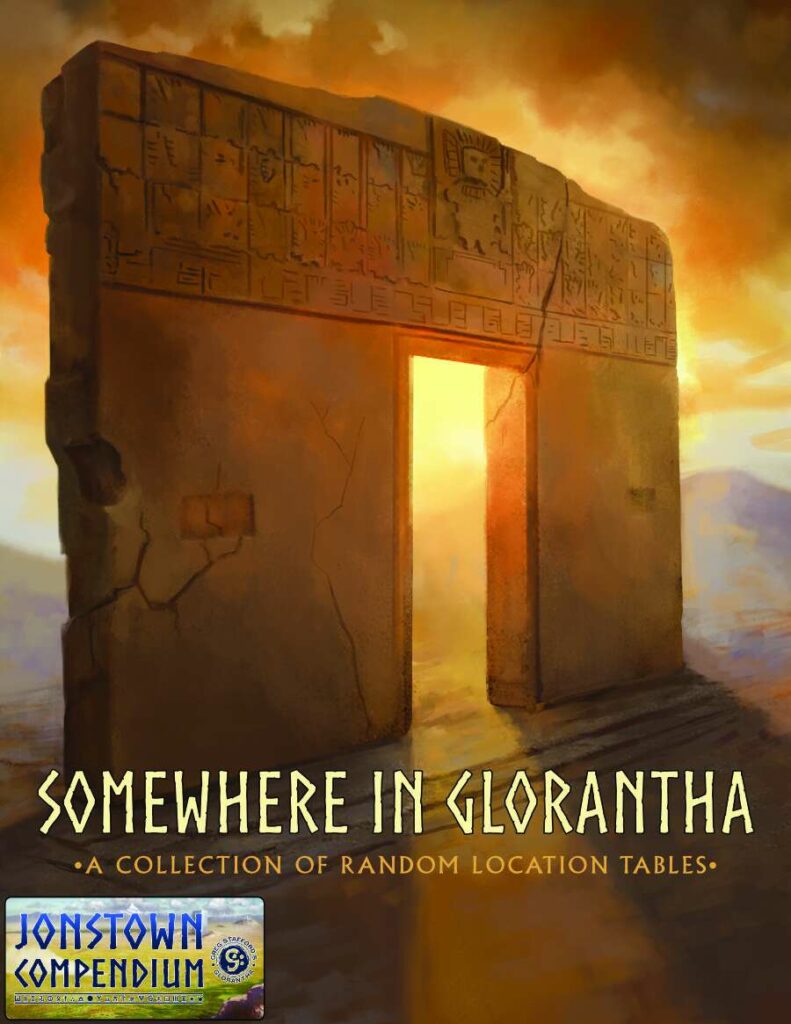
“Somewhere in Glorantha” is a book by Mark Prier that contains a whole bunch of tables for picking a place at random in Glorantha, with references for what book(s) you can find information about it.
Map of Melib

The island of Melib gets the Mikael Mansen treatment. This is a good opportunity for you to check out the write-up for Melib in the Guide to Glorantha, and decide that maybe you should give a boat to your players!
Jeff’s Notes

Jeff Richard, the current mastermind on everything Gloranthan at Chaosium, is often posting notes and thoughts on the RuneQuest Facebook group. Here’s our curated list from the past week. A partial archive of these sources is compiled on the Well of Daliath.
Arkat’s Heirs
Arkat is one of those big chunks of Gloranthan lore that I know little about, so this note about his two alleged sons was a good opportunity for me to go read up on him. Here are some extra notes for your pleasure.
The first son mentioned here is Gerlant Flamesword, who is known to have helped Arkat when he devastated Dorastor. He went on to be a Seshnelan King in the second half of the 5th century. His flaming sword has been part of the royal Seshnelan regalia ever since, even though it has been lost and recovered a few times. Imagine how awkward it would be if one of your players found a “cool flaming sword” in a dungeon, only to have westerners come knocking on his door in Apple Lane soon after…
The other son is more interesting: Talor the Laughing Warrior is the one that cursed the Telmori! Here’s how it went: the Telmori were originally a Hsunshen tribe like the others, with the wolf as their totem animal. But they sided with Nysalor, who gave them the pretty cool blessing of super-duper magical armour. That’s how the Telmori are immune to most weapons while fully or partially in wolf shape. Talor fought the Telmori in the war between Arkat and Nysalor (known as the Gbaji Wars) and managed to curse them with the lycantropy we now know. I’m not sure how much of a curse it is to give your enemies free shape-shifting one day per week but hey, I’m sure it seemed like a good idea at the time.
Talor’s got a bunch of other cool things about him, from being brought back from the dead by Harmast, to being part of some Hero Wars prophecy. Jeff gives some editorial info on it, actually:
Harmast doing the full LBQ twice has been around since Cults of Terror, although I think the Guide was the first publication it was made explicit. Early on, Greg wrote that the first Lightbringers Quest was viewed as a failure when Arkat turned to the darkness, and that Harmast went on a second quest to find proper help. He returned with Talor the Laughing Warrior, who later became the first King of Loskalm.
Talor and Gerlant are now considered “ascendent masters” in some Malkioni sects.
The Divine Fortune of the Empire of Land and Sea
Here is another note on some stuff I know little about: the Middle Sea Empire.
The Empire of Land and Sea, aka The Middle Sea Empire, is the empire of the God Learners. It lasted only a couple centuries, from 789 to 990, but during this time it conquered most of the coastal lands of Genertela and Pamaltela.
For two hundred years the Jrusteli dynasty ruled as the Emperor of the Land and Sea. This was a new title, created in 789 with the acclamation of the Jrusteli Alliance, the Umathelan Coalition, and the Kingdom of Seshnela-Tanisor. At the time, the people acknowledging the Emperor of the Land and Sea as suzerain likely numbered 15-20 million or more, making it easily the largest empire in Gloranthan history.
There’s a bunch more information on the imperial fleet, but what’s interesting to me is the cult of the Emperor himself:
The Emperor of the Land and Sea was the subject of cult, associated with the Runes of Man, Luck, and Mastery. He was often associated with Water as well, as the Emperor had no fixed capital until the oceans were Closed off in 930.
[…]
Across the world, people offered cult to the Divine Fortune of the Emperor, a manifestation of the luck and fortune that made and preserved the Middle Sea Empire. This fortune was lost by Emperor Ilotos around 910 or so, and by 990 the Middle Sea Empire was no more.
There isn’t much about Ilotos unless you go into the wildly non-canonical Mongoose RuneQuest material focused on Glorantha’s Second Age (although some of it is written by Robin Laws, so it might contain a fair amount of Greg-approved material).
I’m not sure if Ilotos is to blame for the fall of Middle Sea Empire, though, as Jeff’s phrasing may or may not imply. As far as I can tell, the last decades of the empire are mostly a series of bad luck and hubris. All the shit the God Learners have been up to for more than a century catches up to them in an apocalyptic way. That’s just life, man.
This was the high point of Malkionism. A world-emperor, subject only to the Invisible God, who was perfectly fine with having Wachaza-worshipping marines and bodyguards, tamed gods and goddesses, and whose sorcerers could summon and command other gods to aid him.
Wachaza is a war god of the water pantheon, worshipped by merfolk and sea-faring fighters alike. You can look up its Rune magic in the Red Book of Magic: Drown (fill up someone’s lungs with water!), Seastrength (double your STR as long as there’s sea-water nearby!), and Fang of Wachaza (a whooping 5-point spell that makes pointy things pretty much as deadly as a Sever Spirit!)
Remember that, unlike what you might hear elsewhere, the Malkioni are not atheists. They very much know that the gods exist… the Malkioni just think they’re way too good to worship them. The gods are, instead, tools, just like spirits. People are tools too, and if letting them worship gods makes them more effective tools, that’s cool.
After the Middle Sea Empire
So we were just talking about the end of the Middle Sea Empire. What comes next?
Malkionism in the Third Age is a pathetic shade of its Second Age glory. The Middle Sea Empire ended in 990 and about a half-century later, Seshnela was shattered by the Luathelans. The great citadels of Malkionism – Frowal, Laurmal, Damolsket, Neleoswal, Orphalsket, and Old Pasos – all destroyed.
The Luathelans are quasi-divine violet-skinned beings that come from the Luathan Islands, at the western edge of Glorantha. There isn’t much known about them because we’re almost in the Gods World at this point: the Luatha Islands are believed to be (among other things) where the Gate of Dusk resides: that’s the giant well in which the sun goes when it sets in the evening. Of course, it leads to the Underworld, and there’s a Gate of Dawn at the eastern edge of the world for when the sun rises in the morning.
When the Closing of the Seas came, the Luathelans showed up in big ships, shoved a large iron pillar into the ground in Seshnela, and triggered some massive quake that shook the whole peninsula and shattered it to bits. About a million people died in one day, and vast amounts of knowledge were lost.
Weep at how much learning was lost in the West and how backwards modern Malkioni would look in the Second Age.
Of note, much later when Dormal re-opened the Seas in 1580, he travelled around Glorantha until, two years later, he disappeared going westward to find Luathela. But anyway, back to the early 1000s:
For three and a half centuries, Seshnela and Tanisor were an anarchy of petty robber baron clans of armored horsemen, who extracted tribute and support from the peasantry. Sorcerous learning survived in a few strongholds, in particular Leplain, the City of Wizards.
Leplain is where the home of the Rokari School of Magic is located, headed by the “Watcher Supreme” (which sounds like a Marvel character, right?) There are a few other schools, too, which makes Leplain one of the most important places for Malkioni sorcery. And with this comes enough political power to backup a Duke of Rindland called Bailifes when he decides to unify the area. This comes with benefits:
[Bailifes] would protect the sorcerers of the Rokari school and grant them oversight over matters of magic and learning. In exchange, they would support Bailifes and his family, and acknowledge them as the rulers.
In 1414, after his cavalry smashed the southern nobles at two battles, the Rokari proclaimed Bailifes King of Seshnela. This alliance between the Bailifids and the Rokari has been extremely successful for both groups, and the Bailifids have suzerainty over all the other “baronial clans”.
The note then describes how this political alliance allowed the Rokari wizard to enforce a few additional rules upon the population: the formalization of the caste system that the Malkioni are so found of (dividing people between rulers, sorcerers, workers, and soldiers), the Rokari having approval/veto power over which gods and spirits are worshipped by the population, and Bailifes becoming “deputy” of the Invisible God. This effectively provides the support system that the wizards need to be full time wizards.
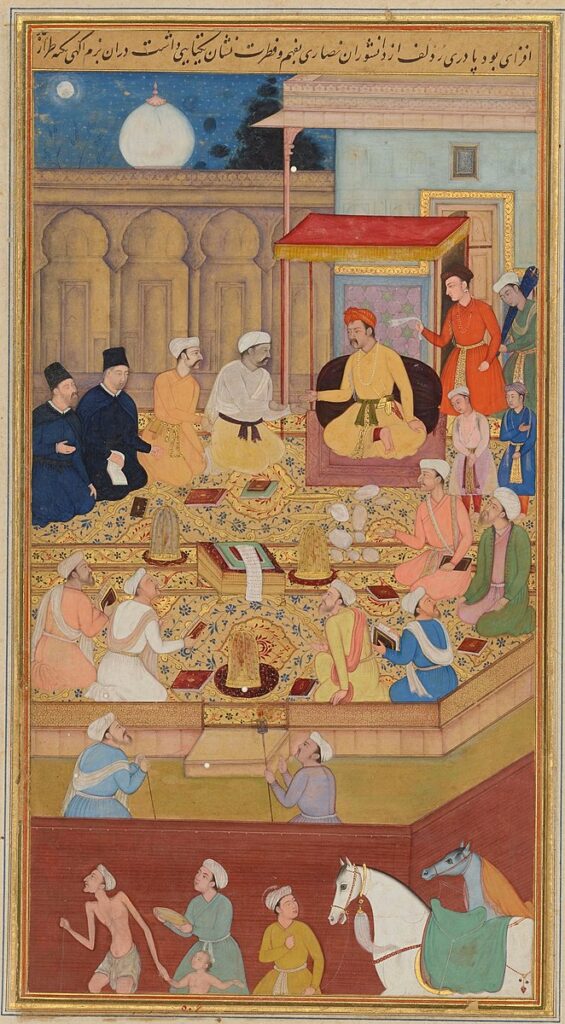
It’s interesting to see Jeff provide an Islamic-Indian picture to give us the vibe of this new Seshnelan nation. That’s a welcome change from the old classic European medieval takes on the Genertelan West, with Merlin-looking alchemists and sorcerers… the picture depicts the Ibadat Khana, a building designed by Mughal Emperor Akbar I in 16th century India as a place where intellectuals and spiritual leads could exchange ideas and teachings. Jeff’s Gloranthan take on the picture is “King Ulianus IV meeting with ranking zzaburi, Safelstran priests, and visiting Brithini“, dating this scene to around 1500 in Glorantha. Funny, it’s close to the real-world date, too!
The Rokari are rightfully called the “realists”. They recognized that they needed to work with the Bailifides, and made a pragmatic bargain that has withheld the test of time. I could imagine a Rokari Machiavelli writing about the need to look at effectual truths rather than “imagined republics and principalities.”
In truth, I imagine that the Secret Secretorum is a common literary conceit where wizards write advice to the king in the form of letters from Malkion to Talor.
The Secretum Secretorum is a series of letters that were supposedly written by Aristotle to his student Alexander The Great, even though it’s almost certainly a book written much later and without much to do with either of these historical figures. Plato and other philosophers used similar techniques in their texts. So I figure that whenever your Lhankor Mhy player character is told to find an “ancient text written by Malkion himself” or whatever, there’s actually a good chance it was simply written by an old philosopher using whatever narrative device was popular at the time… still, that doesn’t mean the text isn’t very valuable!
The Sygian Heresy
There isn’t much about the Stygian Heresy in the main published materials, but from what I understand it describes the various different sects of Arkatists — the people who follow the teachings of Arkat, the First Age anti-hero who embraced Death and Darkness to destroy Nysalor’s Empire of Light. Don’t mix it up with “Stygianism”, a branch of Arkati Malkionism that holds that everything came from Darkness, and to Darkness they shall go back.
Anyway, Jeff looks at Arkat’s teachings, which seem to boil down to “you can’t know what you haven’t experienced“. So you can’t know divinity unless you’ve been a god, and that kind of stuff.
“To destroy a monster, I became a monster. To wield Death, I became Death.”
This sort of talk disturbed our poor rationalists to the very marrow of their bones!
Jeff then explains how, when Arkat’s Dark Empire was destroyed, it was scattered into many small hidden sects that took Arkatism in various directions. When they came back to the open several centuries later, they were so different and disagreeing that they fought each other, over stuff like:
– A group claims to be in contact with the Hidden Arkat (or at least with the hidden heir of Paslac)
– A group claims to know when Arkat will return and is preparing for his return.
– A group claims to know THE secret of Arkat, the one he whispered to his truest companion (whose biological or spiritual descendant founded the sect) and survived the God Learners.
In a follow up note, Jeff goes over what these various sects have in common (knowing secret Arkati stuff, fighting whatever they decide is an incarnation of Gbaji The Deceiver, etc.)
Some sects openly display themselves. However, most hide and pretend to be orthodox Malkioni (especially Rokari) or are initiates of other local cults. […]
The term “Stygian Heresy” is of course not what they call themselves, but it connotes not only Arkat’s associations with Darkness, but the sects’ claims to have secret wisdom and esoteric lineages that they keep hidden “in the Stygian dark.” It does not necessarily mean that the sect worships the Gods of Darkness, although many do (but others worship Lightbringers, in particular Orlanth and Humakt, and still others claim to be Hrestoli).
Malkionism as a Cult
Here’s a glimpse into what it might be like to play as a Malkioni:
So one thing that should be obvious about Malkionism compared to other cults – it is primarily a philosophical system, rather than a connection with a god or spirit. The Invisible God is out of reach – that’s why it is called that. The Invisible God provides no magic in return for worship, any more than Arachne Solara or Glorantha do.
And:
Malkionism has usually co-existed with divine and spirit cults. The Talar Froalar mated with the goddess Seshna Likita and their child Yrealm the Serpent-Legged became the Sacred Lord of Seshnela. Seshna Likita, the Storm God, Magasta, Neliom, etc. all were popular cults. Throughout the First Age, Seshnela was a mix of Invisible God worshipping wizards, divine and spirit cults, Hrestoli “knights”, and rulers that treated this like an a la carte buffet.
But in game, if you are a Malkioni you are either:
1. A wizard, who uses sorcery exclusively.
2. Someone else, who uses a combination of spirit magic and Rune magic (from Ancestor worship, caste appropriate cults, hero cults, etc.), and is buffed by sorcery cast by a wizard.
My take on the west isn’t very original, as I stole it from Ars Magica. I figure that the wizards would only get involved once every few adventures, spending the rest of their time doing research and rituals. The other characters are their servants, bodyguards, and assistants who go on missions on behalf of their master. Troupe play would indeed work well here in my opinion (again, thanks to Ars Magica for that).
Jeff gives details on the Ascended Master hero worship of Xemela, but it doesn’t actually includes gameplay rules. I figure that the wizard’s sidekicks would mix classic cult membership (mostly from the Orlanthi pantheon) and specific hero cults like Xemela’s, each giving one or two Rune spells at most.
Loskalm and New Hrestolism
Loskalm is where some of the Pendragon-esque medieval tendencies of both game designers and players leaked into Glorantha’s otherwise ancient world setting. The reason for this is that most of the area has embraced “New Hrestolism”, a branch of Malkioni philosophy that embraces the caste system (workers, soldiers, wizards, rulers) but at the same time embraces social mobility, wherein most people try to actually pass through all these castes in their lifetime. Those who excel in all castes are “men-of-all”, and have been occasionally described as “knights”, which easily conjures potentially erroneous mental pictures of 8th century Western Europe.
[New Hrestolism] placed a great value on a type of elite horse-riding warrior that wandered around the countryside to right the wrongs done to the common people by the powers that be – called “men-of-all”, but you can imagine them as knight-errants, youxia, bogatyrs, etc. They followed the Code of Hrestol and were expected to be equally skilled with sword, horse, spear, poem, lore, and courtesy.
In order to mix up your mental pictures, Jeff here provides other references — although they all basically refer to “cool looking errand hero who goes back on the road after each adventure“. Besides the European knight-errant (like Lancelot) and the Chinese youxia (like the old TV-series Kung-fu!), you could also include the Japanese ronin (like in Kurosawa’s most famous movies). I didn’t know about the Eastern European bogatyr but it’s the same idea.
Jeff tries to explain that this man-of-all concept is somewhat linked to the “dualism” that exists at the core of Hrestolism:
In Loskalm, Malkionism developed a strong current of dualism, positing that the Invisible God’s awareness of itself created a lesser (and flawed) demiurge that in turn created lesser emanations – powers, elements – which in turn multiplied and combined, which resulted in the gods. The gods were flawed and self-willed and fought among themselves, bringing Chaos into the world. All of material reality is thus tainted with entropy and corruption. Ideals became associated with light and the good; matter became associated with darkness and evil.
I don’t really see the link between the two, so…. ok? Maybe the point is that they want to go back to the idealism of the single creator entity who does and is everything, so they build their society in a way that selects for exceptional people who can indeed do and be everything, from farmer to artisan to soldier to philosopher to ruler? I don’t know, I was always taught that multi-classing was inefficient…
The good thing is that Jeff also explains clearly for the first time why the hell the Syndics Ban happened. You might remember that Prince Snodal, a great Loskalmi man-of-all, killed the Fronelan God of Communication and cut off most of northwestern Genertela from the rest of world, with various regions effectively living in their own little pocket reality.
The most famous of these wandering heroes, Prince Snodal, saved Loskalm from its doom when he organised the conspiracy that slew the God of the Silver Feet and instituted the Syndics Ban. The Ban cut Loskalm off from the corrupt world and allowed Prince Snodal’s son Siglat the Wise to radically reform Loskalmi society and institutions.
I guess that’s protectionist politics taken to an extreme. I hope the UK government doesn’t read Gloranthan lore, or they might get more bright ideas…
Anyway, read the rest of the note for some details on the New Hrestoli caste system, some population numbers for Loskalm, and various other comments on Snodal, the ban, and usable references. In particular, you’ll see that the fact that caste mobility exists doesn’t mean everybody can do what they want — you still need to go through a (probably very nepotic) vetting system to upgrade from one caste to the next! But note how Loskalmi people start learning sorcery at the latest when they get to the “Guardian” (soldier) level.
The Lightbringers Belt & Old Gods
Here’s a rough look at where the big religion types are located in Genertela:
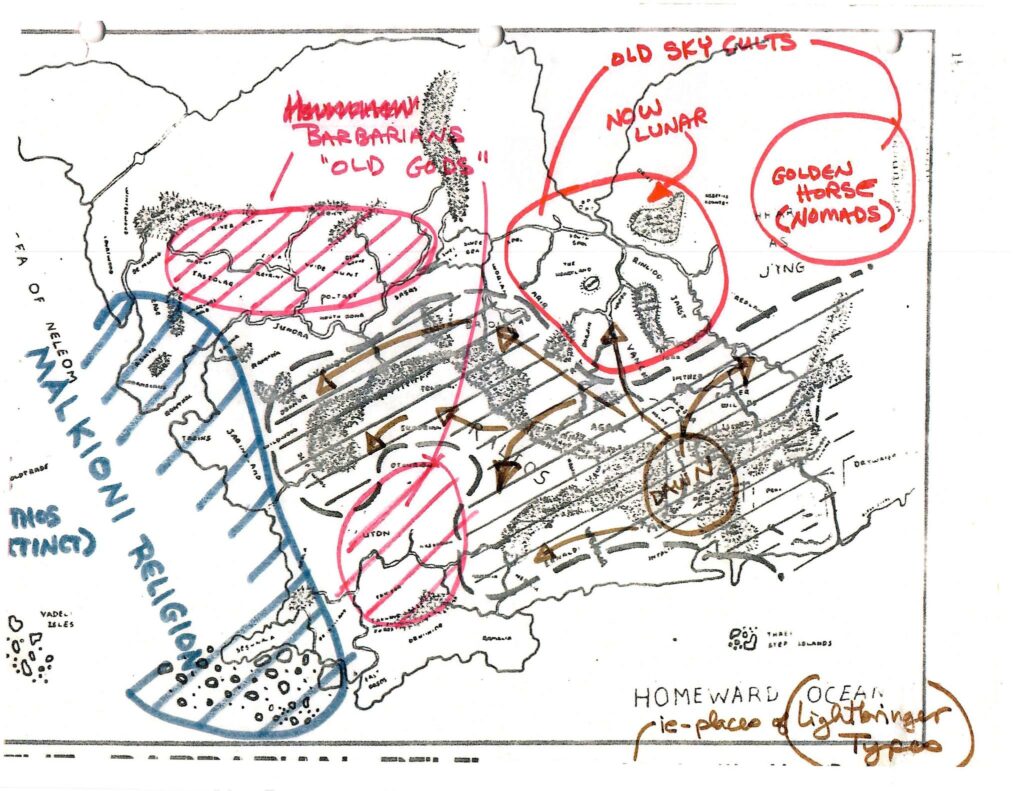
You’ve got the Malkioni and the Lightbringer worshippers and the Lunars and such. But there’s also the “Barbarian ‘Old Gods'”.
These are areas that in the First Age were predominantly a combination of Hsunchen and other Beast cults, spirit cults and shamanism. Pendali, Telmori, Galanini, Tawari, etc. They got exposed to both the Lightbringers and Malkioni, and sampled both like an à la carte buffet. Along the Janube River, we have the Arrolian Territories, as well as the Sky-worshippers. In Safelster, we have Stygian heresies, Ehilm worship, city gods, and grain goddesses, as well as Lightbringers and orthodox Malkioni.
Those “Old Gods” areas are going to be some of the more heterogenous areas in Genertela. Every city might have a different ruling cult, or even no ruling cult at all.
Read the note for some example of how a given area can mix up classic Orlanthi religion with old Second Age traditions and more.
Lhankor Mhy Sorcery
The Malkioni aren’t the only ones using sorcery: as a starter RuneQuest character you can do a bit of it yourself with, say, the Lhankor Mhy cult.
But the Knowing Priests are largely self-taught amateurs when it comes to sorcery. Temples tend to know a limited subset of spells and that’s about it. Knowing Priests are of course welcome to learn more – but remember, Malkioni wizards aren’t just going to teach their secrets to some barbarian scribe!
Lots of good details in that note to put into context Lhankor Mhy’s relationship with sorcery.
World Building Glorantha
Now this is my jam: world-building spreadsheets!

Jeff shares a bit about his thought process when world-building a region. This is similar to mine actually. I built a similar spreadsheet when figuring out my Far Place campaign:
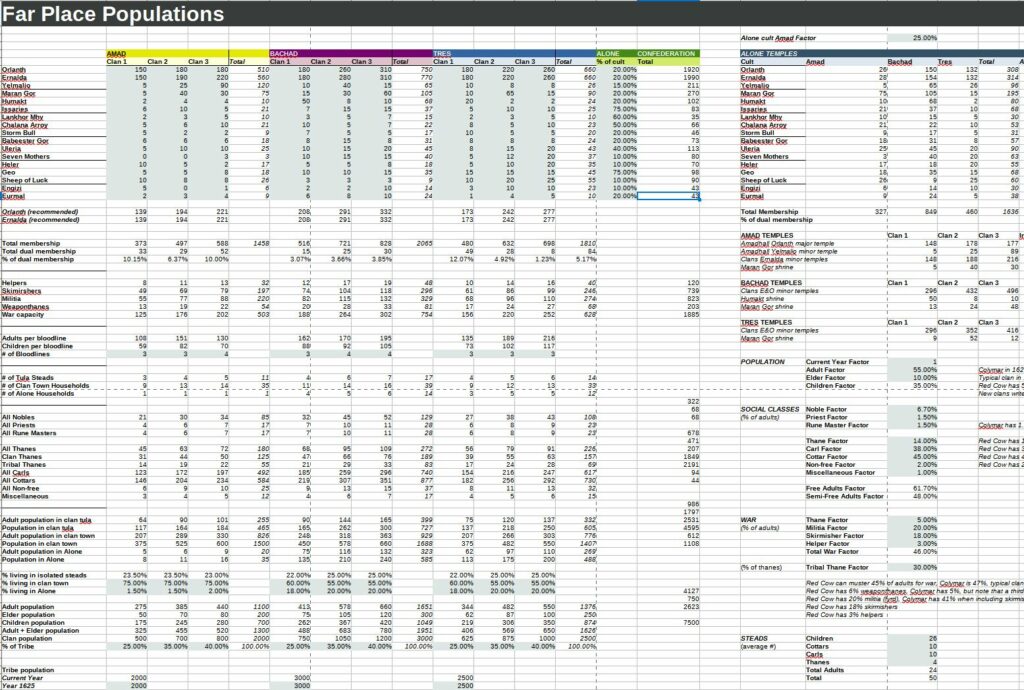
Of course, back when I built this spreadsheet I only had a couple of data points: the Colymar tribe from the gamemaster pack, the Red Cow campaign books, and so on. That’s why if you zoom in, you’ll see I’m combining old terms like “carls” and “cottars” with newer concepts. I could clean up this spreadsheet quite a lot now that we have more modern RuneQuest data points…
The Machine Ruins
Here is a note about the Clanking City, which was home to a bunch of atheistic sorcerers and crafters and smiths who literally built an artificial deity know as the Machine God. The neighbours didn’t like the noise and the smell, but probably above all they didn’t like the idea behind the whole thing.
The dwarves, trolls, humans, and dragonewts of the Shadowlands united to destroy this abomination.

The ten-year siege of the Clanking CIty became one of the epic battles at the end of the Second Age. The inhabitants were aided by wizards who also lived near the isle, and by many Jrusteli refugees from other cities. The struggle is known to people from all over the region, and for a while it almost seemed that the Elder Races would forge anew the forgotten unity of the past. Through such cooperation, the city finally fell, Its inhabitants slaughtered, its stones scattered, and its metals plundered.
What’s left behind is a mix of “Da Vinci-punk” contraptions and blueprints lost in the middle of stone and metallic ruins, protected by troll spirit guardians who don’t want anybody to get any idea from looking to closely at all that crap.
There are more details in the note, along with some comments about Esvularela and the Bandori valley.
The Shadowlands

Last is a note about the Shadowlands, which as far as I understand was the name of most of the Holy Country in the First Age when the trolls (and the Only Old One) ruled the entire place. They did this mostly through the Shadow Tribute, which everybody around there paid as a “thank you” to the trolls for helping them survive the Great Darkness.
Anyway, Jeff provides details about the Jrusteli and the Empire of the Wyrm’s Friends’ assets in the area, and the possible cultural exchange that happened between the two.
Community Roundup
The community roundup is our highlight of interesting things being mentioned in the Glorantha-related Facebook groups, sub-Reddits, and other similar online places.
A Case of Multiple Enshrinment
Over on her blog Eight Arms And The Mask, Effy is up to some deep Lunar shenanigans again.
When we came to the place under question, myself, two scribes, six others of the hazar rank, and eight peasant baggage carriers, I was immediately appalled to see the condition of the temple complex. They had removed what seemed to be half of the shrines, most especially the one to the Red Goddess of the east and to our benevolent ally her son etc. I looked about for a functionary to smite with my staff of office, or possibly even my fist. One came forth, but alas, he too was of the vizier rank and so I could do no more than perform the Vibratio Castigiationis at him.
Since I haven’t read the Stafford library, I’ve got no idea what I’m looking at, but hey as always it’s well written and a bit funny. I’m sure Joerg will be able to say something more insightful than me, though.
Sumerian Bar Jokes
It’s hard to translate jokes written in a long-dead language:
The earliest example of a bar joke is Sumerian, on a tablet dating from the early Old Babylonian Empire (c. 1894–1800 BC), and it features a dog: “A dog, having walked into an inn, did not see anything, (and so he said): ‘Shall I open this (door)?’.” One proposed explanation of the joke is that the punchline presumes an inn would also be a brothel, and the humour suggests the dog is hoping to see what transpired out of view. Another proposed explanation is that the joke refers to the opening of the eyes, the punchline being that the dog could not see anything because its eyes were closed.
This deep dive into the Sumerian language on Twitter brings some more light onto this whole affair. I won’t blame you if you’re left thoroughly unimpressed by Sumerian humour.
Win Some PDFs by Exploring Glorantha

Iconic Productions, makers of Exploring Glorantha (among other things) is running a contest in which you can win Drew Baker’s “Return to the Big Rubble” PDFs! Check out their Facebook and Twitter accounts for more information.
Elsewhere on Arachne Solara’s Web
Not everything is about Glorantha, although most things are! Here are loosely relevant things that we found on the interwebs.
Persepolis Reimagined
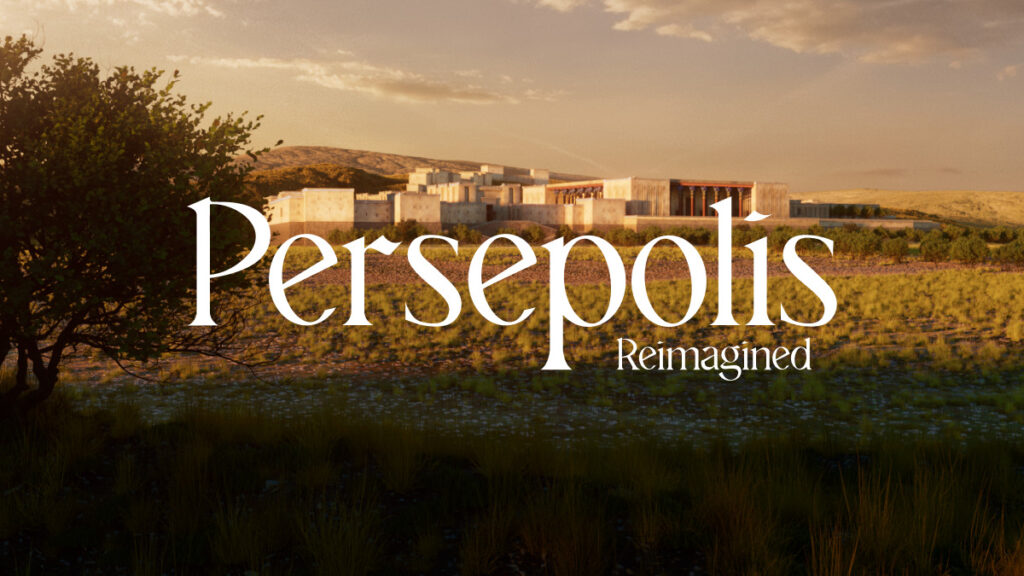
Persepolis was the “ceremonial capital” of the Achaemenid Empire, dating back to around 500 BC. Its ruins are now in modern day Iran. Many reconstructions have been made of the city and its magnificent gates and temples, but not all of them can be experienced in your browser! Check out this beautifully interactive visit of the city: Persepolis Reimagined.
Make sure to run this on a good machine, and preferably with some audio. The music and 3D graphics are quite nice but got my old laptop to overheat badly. All fine on my desktop computer though.
The Dispilio Tablet
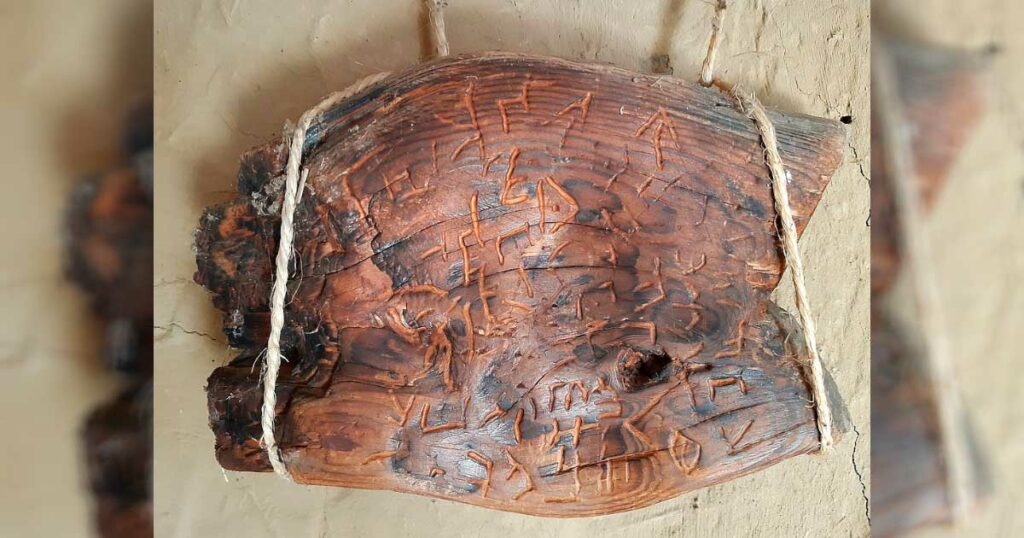
David Scott points to a recent article on the Dispilio tablet, a greek artifact discovered in 1993 that features some early forms of writing from 5200 BC. The article gets a bit sensationalist about “the Real Origins of Writing” (this is common on Ancient Origins), but in reality it’s a bit more complicated — it really depends what you consider “proper” writing and what you consider “proto-writing” (some of which goes back to the 7th millenium BC in a few different spots on the planet).
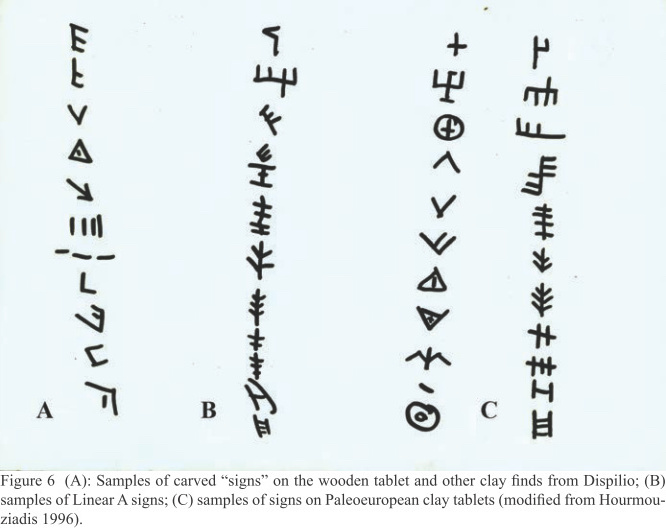
Anyway, the fun thing that David spotted is the similarity between the Dispilio glyphs (above) and some of the Gloranthan runes and symbols:
For comparison see:
– Excerpt – Appendix E: Dara Happan Sacred Alphabet
– Khordavan Font
– Runes and Glyphs used on this site
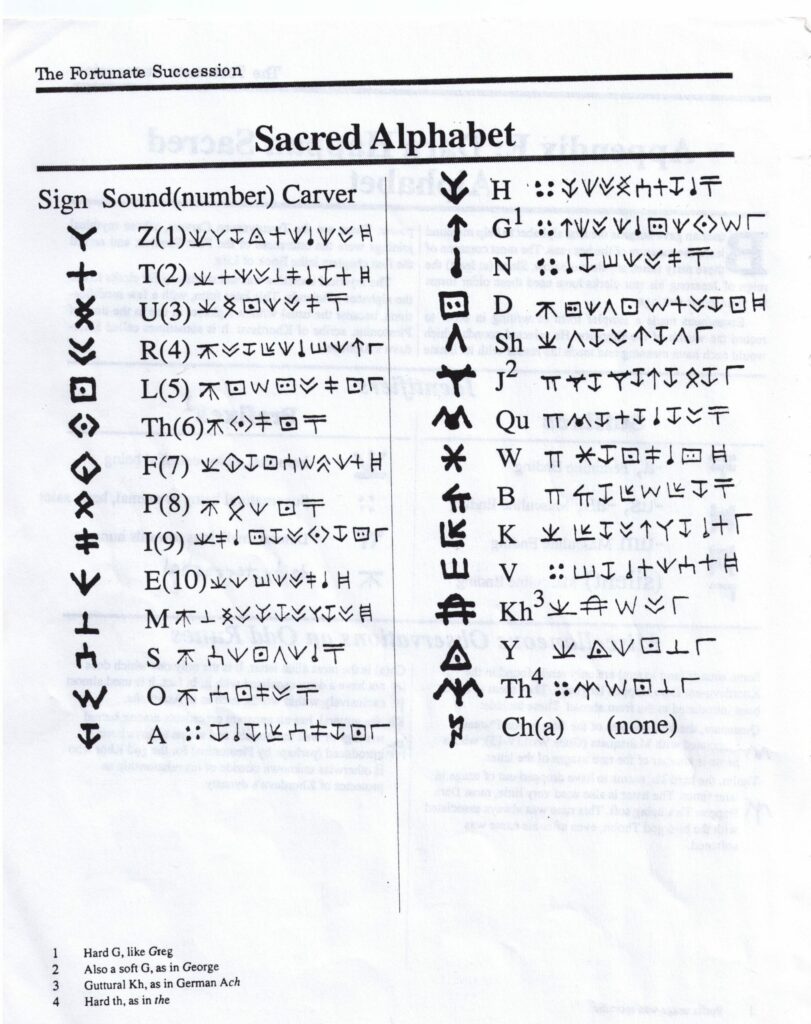
Thank you for reading
That’s it for this week! Please contact us with any feedback, question, or news item we’ve missed!


